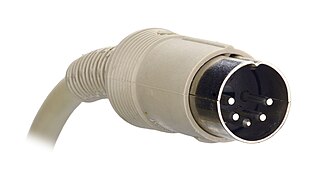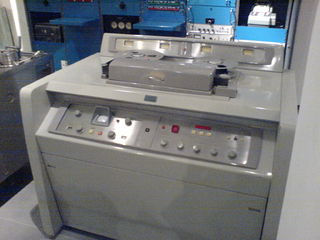Related Research Articles

Magnetic tape is a medium for magnetic recording, made of a thin, magnetizable coating on a long, narrow strip of plastic film. It was developed in Germany in 1928, based on magnetic wire recording. Devices that record and playback audio and video using magnetic tape are tape recorders and video tape recorders respectively. A device that stores computer data on magnetic tape is known as a tape drive.

VHS is a standard for consumer-level analog video recording on tape cassettes.

An audio tape recorder, also known as a tape deck, tape player or tape machine or simply a tape recorder, is a sound recording and reproduction device that records and plays back sounds usually using magnetic tape for storage. In its present-day form, it records a fluctuating signal by moving the tape across a tape head that polarizes the magnetic domains in the tape in proportion to the audio signal. Tape-recording devices include the reel-to-reel tape deck and the cassette deck, which uses a cassette for storage.

Videotape is magnetic tape used for storing video and usually sound in addition. Information stored can be in the form of either an analog signal or digital signal. Videotape is used in both video tape recorders (VTRs) or, more commonly, videocassette recorders (VCRs) and camcorders. Videotapes are also used for storing scientific or medical data, such as the data produced by an electrocardiogram.
A cassette deck is a type of tape machine for playing and recording audio cassettes that does not have built-in power amplifier or speakers or both, and serves primarily as a transport. It can be a part of a automotive entertainment system, or a part of a portable mini system, or a part of a home component system. In the latter case it is also called a component cassette deck or just a component deck.
Vision Electronic Recording Apparatus (VERA) was an early analog recording videotape format developed from 1952 by the BBC under project manager Dr Peter Axon.

Ampex is an American electronics company founded in 1944 by Alexander M. Poniatoff as a spin-off of Dalmo-Victor. The name AMPEX is a portmanteau, created by its founder, which stands for Alexander M. Poniatoff Excellence. Today, Ampex operates as Ampex Data Systems Corporation, a subsidiary of Delta Information Systems, and consists of two business units. The Silicon Valley unit, known internally as Ampex Data Systems (ADS), manufactures digital data storage systems capable of functioning in harsh environments. The Colorado Springs, Colorado unit, referred to as Ampex Intelligent Systems (AIS), serves as a laboratory and hub for the company's line of industrial control systems, cyber security products and services and its artificial intelligence/machine learning technology.

Multitrack recording (MTR), also known as multitracking or tracking, is a method of sound recording developed in 1955 that allows for the separate recording of multiple sound sources or of sound sources recorded at different times to create a cohesive whole. Multitracking became possible in the mid-1950s when the idea of simultaneously recording different audio channels to separate discrete "tracks" on the same reel-to-reel tape was developed. A "track" was simply a different channel recorded to its own discrete area on the tape whereby their relative sequence of recorded events would be preserved, and playback would be simultaneous or synchronized.

The Digital Compact Cassette (DCC) is a magnetic tape sound recording format introduced by Philips and Matsushita in late 1992 and marketed as the successor to the standard analog Compact Cassette. It was also a direct competitor to Sony's MiniDisc (MD), but neither format toppled the then-ubiquitous analog cassette despite their technical superiority, and DCC was discontinued in October 1996.

Helical scan is a method of recording high-frequency signals on magnetic tape. It is used in open-reel video tape recorders, video cassette recorders, digital audio tape recorders, and some computer tape drives.

Reel-to-reel audio tape recording, also called open-reel recording, is the form of magnetic tape audio recording in which the recording medium is held on a reel that is not permanently mounted in an enclosed cassette. In use, the supply reel containing the tape is placed on a spindle or hub; the end of the tape is manually pulled out of the reel, threaded through mechanical guides and a tape head assembly, and attached by friction to the hub of the second, initially empty takeup reel.

A DIN connector is an electrical connector that was originally standardized in the early 1970s by the Deutsches Institut für Normung (DIN), the German national standards organization. There are DIN standards for various different connectors, therefore the term "DIN connector" alone does not unambiguously identify any particular type of connector unless the document number of the relevant DIN standard is added. Some DIN connector standards are:

A video tape recorder (VTR) is a tape recorder designed to record and play back video and audio material from magnetic tape. The early VTRs were open-reel devices that record on individual reels of 2-inch-wide tape. They were used in television studios, serving as a replacement for motion picture film stock and making recording for television applications cheaper and quicker. Beginning in 1963, videotape machines made instant replay during televised sporting events possible. Improved formats, in which the tape was contained inside a videocassette, were introduced around 1969; the machines which play them are called videocassette recorders.

A tape head is a type of transducer used in tape recorders to convert electrical signals to magnetic fluctuations and vice versa. They can also be used to read credit/debit/gift cards because the strip of magnetic tape on the back of a credit card stores data the same way that other magnetic tapes do. Cassettes, reel-to-reel tapes, 8-tracks, VHS tapes, and even floppy disks and modern hard drive disks all use the same principle of physics to store and read back information. The medium is magnetized in a pattern. It then moves at a constant speed over an electromagnet. Since the moving tape is carrying a changing magnetic field with it, it induces a varying voltage across the head. That voltage can then be amplified and connected to speakers in the case of audio, or measured and sorted into ones and zeroes in the case of digital data.

D-2 is a professional digital videocassette format created by Ampex and introduced in 1988 at the NAB Show as a composite video alternative to the component video D-1 format. It garnered Ampex a technical Emmy in 1989. Like D-1, D-2 stores uncompressed digital video on a tape cassette; however, it stores a composite video signal, rather than component video as with D-1. While component video is superior for advanced editing, especially when chroma key effects are used, composite video was more compatible with most analog facilities existing at the time.

2-inch quadruplex videotape was the first practical and commercially successful analog recording video tape format. It was developed and released for the broadcast television industry in 1956 by Ampex, an American company based in Redwood City, California. The first videotape recorder using this format was built in the same year. This format revolutionized broadcast television operations and television production, since the only recording medium available to the TV industry before then was film used for kinescopes, which was much more costly to utilize, could only be used once, images could be ruined by light leaks if the film was not developed and took time to develop at a film laboratory. In addition, kinescope images were usually of obviously inferior quality to the live television broadcast images they recorded, whereas quadruplex videotape preserved almost all the image detail of a live broadcast.

Multitrack recording of sound is the process in which sound and other electro-acoustic signals are captured on a recording medium such as magnetic tape, which is divided into two or more audio tracks that run parallel with each other. Because they are carried on the same medium, the tracks stay in perfect synchronisation, while allowing multiple sound sources to be recorded at different times.

A videocassette recorder (VCR) or video recorder is an electromechanical device that records analog audio and analog video from broadcast television or other source on a removable, magnetic tape videocassette, and can play back the recording. Use of a VCR to record a television program to play back at a more convenient time is commonly referred to as timeshifting. VCRs can also play back prerecorded tapes. In the 1980s and 1990s, prerecorded videotapes were widely available for purchase and rental, and blank tapes were sold to make recordings.

Music Center Incorporated (MCI) is the former name of a United States manufacturer of professional audio equipment that operated from 1955 until 1982 when it was acquired by the Sony Corporation. The company is credited with a number of world firsts: commercialising the 24-track multi-track recorder, the tape Auto Locator and in-line mixing console.
A sound follower, also referred to as separate magnetic, sepmag, magnetic film recorder, or mag dubber, is a device for the recording and playback of film sound that is recorded on magnetic film. This device is locked or synchronized with the motion picture film containing the picture. It operates like an analog reel-to-reel audio tape recording, but using film, not magnetic tape. The unit can be switched from manual control to sync control, where it will follow the film with picture.
References
- ↑ Ross Snyder interviewed by Howard Sanner about the history of Les Paul's eight track Ampex 300 and Sel-Sync, 11 Mar 2000
- ↑ Ampex Sel-Sync, 1955 Archived 2010-01-31 at the Wayback Machine
- ↑ Snyder, Ross (2003). "Sel-Sync and the "Octopus" : How Came to be the First Recorder to Minimize Successive Copying in Overdubs" (PDF). ARSC Journal. 34 (2): 209–213.